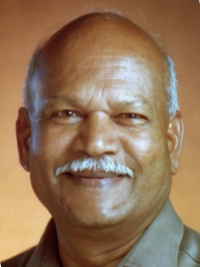The Mahāmastaka Abhiśeka of Gommaṭa alias Bāhubali’s 58.8 foot monolithic colossus, consecrated on the crest of Vindhyagiri (Doḍḍa Beṭṭa) at Śravaṇabeḷagoḷa, starts from 8th February 2006. Since it is going to be the first head-anointment celebration of the 21st century, obviously the great event has created lot of curiosity. Synchronising this unique auspicious event, a remarkable ancient image of Bāhubali deserves special attention and consideration.
So far, the earliest known sculptures of Bāhubali come from the two Jaina caves at Aihoḷe and Bādāmi respectively in Bāgalakoṭe Dt. (Karnataka). The two sculptures of Bāhubali, one each from Aihoḷe and Bādāmi Jaina caves, are relievos and not independent images. The reliefs are datable to late sixth century CE, the period of Bādāmi Calukyas.
Astonishingly, the earliest extant independent image of Bāhubali comes from the celebrated place of Śravaṇabeḷagoḷa. It is a magnificent bronze image datable to late seventh century, again the age of the Imperial Calukyas of Bādāmi. This rare image is preserved in the Prince of Wales Museum, Mumbai.
But, one more image has recently come to light which is far earlier than the bronze image in Prince of Wales Museum and the relievos in the Jaina Caves at Aihoḷe and Bādāmi. The veteran art-historian Umakant P. Shah has noticed a none-such metal image of Bāhubali tracing it from the individual collection of Prof. Samuel Eilenberg. Considering and contemplating the stylistic features of this brilliant metal image, it may be assigned to late fourth century CE. In other words it belongs to the Kushan epoch. Thus, it has become the earliest Bāhubali image discovered so far. Hence the historical significance of this eldest extant image needs no exaggeration. Interestingly it was discovered in the region around north Karnataka. The matchless metal image has been preserved in the Metropolitan Museum, New York (USA).
The importance of this ancient and earliest known representation of Bāhubali deserves a detailed discussion. The rapidly flowing stream of Bāhubali's theme and its expression in art, architecture, culture and literature evolved from Karnataka, which gave a definite shape to the concept of a rebel prince who finally renounced all terrestrial interests to become, a rare recluse and to be revered by one and all.
The extraordinary nude figure of Bāhubali in the raised up erect posture of meditation without any apparel or ornament is fascinating. It depicts the youthful and robust Bāhubali standing on a full bloomed double lotus, broader at base. Bāhubali has a pleasing countenance. The Mādhavi creepers entwine his legs and arms. It is interesting to note the treatment of hair on his head combed back in parallel lines and eight hair locks shown falling on Bāhubali's front and back shoulders. None of the extant Gommaṭa images or sculptures depict tresses falling back of shoulders so neatly as this newly discovered metal image. Analogous with the bronze image in the Prince of Wales Museum, this metal image also does not depict ant-hill, serpents, and the two ladies in the flank. Albeit, in the evolution of Bāhubali’s sculpture, this metal image would be the first and best proto-type which inspired the subsequent artists. Indeed it is curious that this majestic image had remained largely unnoticed, except for an handful of scholars. I am grateful to the Metropolitan Museum (New York) for sending the original photographs and permitting to publish it.
The sculpture of Bāhubali has a rich hoary and unbroken tradition. Bāhubali images are found throughout the length and breadth of India from the fourth century, the Kushan period. There are hundreds of images in stone and metal and speak of the cult of Bāhubali.
But the monolithic colossus of 58.8 feet on the summit of Vindhyga at Śravaṇabeḷagoḷa is unique. It was consecrated in the year 981 CE. It was commissioned by Cāmuṇḍarāya who was army chief and Minister. The Bāhubali image was chiselled out of a solid rock. It was not transported to the top of the Hill. Contrarily it is part of the Hill. 1'he lovely image is matchless for various reasons. It is in the open air and has withstood the vagaries of nature for a thousand years and more. Exposed to wind, sunlight, rain and cold, it is remarkable that the image has not lost its beauty. Though naked the onlooker will not get disturbed and instead will be enthralled with spiritual and divine experience. Once in every 12 years devotees from every nook and corner of the globe come to participate in the celebrated mahā-mastaka-abhisheka, the great head lustration. Mahā-mastaka-abhisheka is a sight even for gods to see. With various substances, commencing from water, tender coconut water, milk, turmeric, sandal wood paste, rice powder etc. The festival is colourful and superb.
 Prof. Dr. Nagarajaiah Hampana
Prof. Dr. Nagarajaiah Hampana
